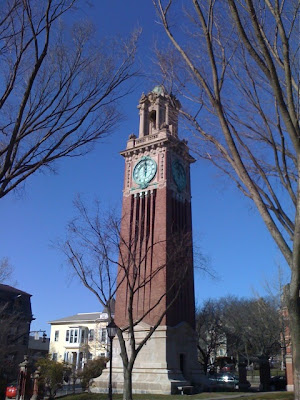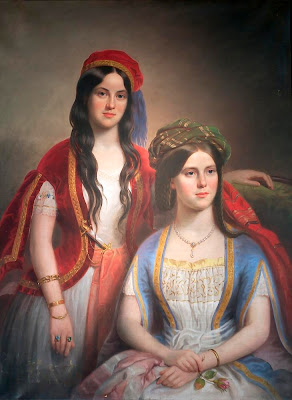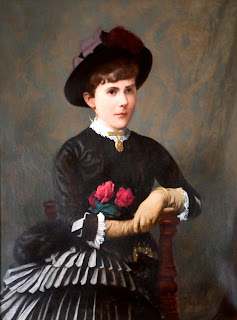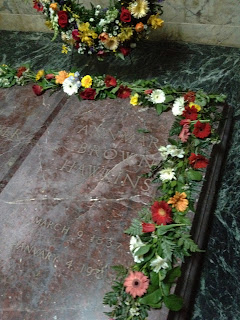Contrary to what you might think, Transit Street in Providence is NOT named after a public transportation system, or because it is a route from one place to another. It is so called because in June 1769 an astronomical phenomenon known as the Transit of Venus occurred. It was observed by scientists all over the world--including a Providence, Rhode Island contingent. They planned an observation platform and equipment installation on the crest of College Hill, 100 feet east of Benefit Street near the southern end of Thayer Street, not far from what is now Transit Street. They spent months ordering equipment from England, and planning, designing, and constructing the necessary facilities.
So what is the Transit of Venus? It describes the visible passage of the planet Venus between the earth and the sun. It occurs in a pattern where there are two December observations 8 years apart, followed some years later by two June observations 8 years apart. There are 243 years between one June observation pair and the next, and the same between each December observation pair. So, for example, a December pair occurred in December 1631 and December 1639. A June pair occurred in June 1761 and June 1769. The next observations were in December 1874 and 1882, followed by the current pair in June 2004 and June 2012.
 |
| Portrait of Benjamin West in later life |
Benjamin West, a self-taught astronomer from Rehoboth, Massachusetts, documented the Providence group's efforts in his
Account of the Observation of Venus Upon the Sun, The Third Day of June, 1769, at Providence, in New-England, With some Account of the Use of Those Observations. Other noted local participants included
Joseph Brown and his brother
Moses,
Gov. Stephen Hopkins, and
Dr. Jabez Bowen.
 |
| The telescope used in the observation |
Except for Hopkins, who'd already served nine terms as Governor of the Colony, and was in his sixties, the rest were young--in their thirties. And reading West's document, you can feel the excitement and enthusiasm of the group through the stilted 18th-century language. West describes the arrival from England, a month before the Transit, of a "three feet reflecting telescope" along with "a curious helioscope, together with a micrometer of a new and elegant construction." The group also had a "sextant belonging to the government" which had been made in Newport, and "two good clocks, one of which was made in Providence, by Mr. Edward Spalding." They had no documentation on how to use the micrometer, so they had "recourse to experiments." "These experiments were repeated every fair day . . . till we could many times going find the diameter of a body to a second of a degree." They hoped to be part of the worldwide effort to determine the scale of the solar system (and also to determine/verify the latitude of Providence).
They were also very concerned with the regulation of their clocks, and to do this they hired artisans who "were employed in laying a platform, of seasoned pine plank, as smooth and level as art could make it." They examined the platform three times a day "with a very long level, made for that purpose, in order to keep its position from altering." On one side of the platform they built a 10-foot stile into which they "fixed the glass of a scioptic ball" which would allow the sun's rays to be transmitted onto the platform. They then drew "a great number" of concentric circles in order to trace a meridian line. "Notice was given beforehand to the people (whose curiosity was excited by the preparations) that on the day before the transit, when the Sun came on the meridian, a cannon would be fired, which being done, most of the inhabitants marked meridian lines in their windows, or on their floors."
They also used the sextant and reflector for several days before and after the transit to "ascertain the going of the clocks. . . . We found, upon the whole, a surprizing agreement in these two methods of regulating clocks; they were seldom found to differ a single second."
June 3 dawned bright and clear, and the colleagues gathered at the site early so as not to miss the observation. Florence Parker Simister, in her
Streets of the City: An Anecdotal History of Providence, wrote: "Crowds of curious spectators, and those interested in scientific matters, gathered at the observatory, while Governor Stephen Hopkins, Dr. Benjamin West, and Joseph Brown looked through their instruments and made their calculations." Records show that the transit started a little after 3 p.m., and West, Brown, et al took measurements until the last rays of the sun disappeared.
In today's hectic and electronics-fueled world, it's hard to imagine the enormous interest of the community in this endeavor. But the citizens of Providence were clearly impressed, naming not only Transit Street in honor of the occasion, but also the nearby Planet Street.
Epilogue
Benjamin West would receive honorary degrees from Harvard and Brown (then known as The College of Rhode Island) the year after the Transit. After the war, he would become a professor of mathematics and astronomy at Brown.
Joseph Brown, in addition to his scientific interests, was also an architect, and in the years to come would design many of the 18th century buildings that still survive in Providence, including the John Brown House, the Joseph Brown House, Market House on North Main Street, University Hall at Brown University, and the First Baptist Church on Benefit Street.
Moses Brown later co-founded Slater Mill in Pawtucket in 1790. This was the first water-powered spinning mill in America and signaled the beginning of the American Industrial Revolution. He also founded what is now known as the Moses Brown School in Providence, introduced smallpox vaccine to Rhode Island, and was a founding member of the Rhode Island Historical Society.
Jabez Bowen became Deputy Governor of Rhode Island, and was named Chief Justice of the RI Supreme Court in 1781.
Stephen Hopkins would go on to be one of the signers of the Declaration of Independence.
Illustration Credits
The photo of the Transit and Benefit Street signs was found on the
Coalition for Transportation Choices website.
The portrait of Benjamin West is in the Brown University portrait collection, and hangs in the John Hay Library. The image was found on the
Brown University website.
The photograph of the telescope also comes from the
Brown University website; the telescope is also displayed at Brown.


















